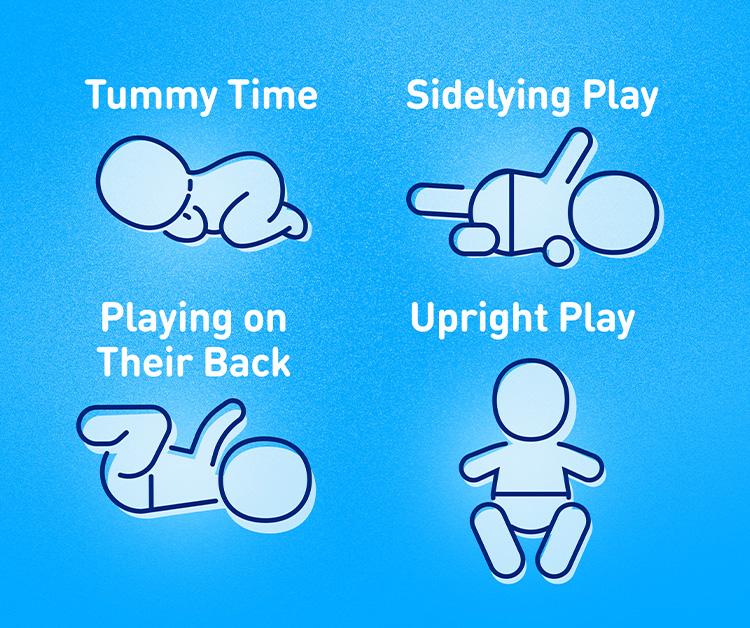Website maintenance scheduled Jan. 9-12; Rebates unavailable Jan. 5-20.

How can I support my baby’s motor development? Dr. Brita DeStefano, Enfamil’s Movement Expert, shares the importance of motor development and activities that can help babies achieve strength and control in their tiny bodies.

Medically reviewed by a board-certified pediatrician
As a pediatric physical therapist with over a decade of experience and mom of two, I have a deep passion for educating families and creating resources to help caregivers demystify their child’s motor and overall development. As a result, I’ve been enlisted to be part of Enfamil’s Village of Experts as their Movement Expert – to help develop the ultimate resource for parents to better understand their baby’s milestones.
First, what is motor development? It refers to a child’s physical skill growth that allows them to interact with their environment. These physical abilities are achieved in predictable patterns that start from the top (controlling their head movements) and work their way down the body. This means infants typically achieve strength and control of their upper body before their lower body.
So, how exactly does infant motor development happen? There are some basic principles and characteristics that are helpful for parents to understand.
Dr Brita’s #1 Tip & Reminder: The most important thing for parents to remember is that every baby develops at their own pace and all of the mini-milestones along the way matter just as much as the big ones that are on their pediatrician’s checklist.
With those basics under our belt, let’s dive into some ways parents can help support their infant’s motor development. In general, giving a child ample floor time and varying their play positions is the best way to set them up for success.
|
Tummy Time | ||
|---|---|---|
|
0-2 Months |
3-4 Months |
5-6 Months |
|
Tips: Start by laying baby on your chest or across your lap
Use black and white cards to get their attention–encouraging head movement and assisting with visual and cognitive development
Result: Your child will be just beginning to lift their head a little bit |
Tips: Prioritize tummy time down on the floor Use a mirror and lift toys up higher to encourage baby to lift their head up more
Result: Your baby will be lifting their head to 90 degrees and starting to push up with their arms |
Tips: Focus on movement – Roll baby in and out of tummy time and put toys just out of reach to encourage grabbing
Result: Your baby will begin shifting their weight onto one arm so they can reach to grab or knock over toys like stacking cups |
Sidelying Play | ||
|---|---|---|
0-2 Months | 3-4 Months | 5-6 Months |
Tips: Lay baby on their side in your lap or on the floor
Result: Your baby will mostly just rest in the position but may also begin to discover their hands and bring them together. | Tips: Do it on the floor with a mirror or other toy for baby to look at Give them a toy to manipulate with both hands and even bring to their mouth
Result: Your baby will become more active in the position. Maybe even trying to lift their head up a little off the ground. | Tips: Use sidelying as a short stopping point while practicing rolling in and out of tummy time
Result: Baby has more control in the position and can get in and out of it on their own while they roll. |
|
Playing On Their Back | ||
|---|---|---|
|
0-2 Months |
3-4 Months |
5-6 Months |
|
Tips: Lay baby on their back on the floor Use black and white images to gain their visual attention then move it slowly in an arc from side to side while baby follows it with their head
Result: Your child is gaining head control (the first foundational movement needed for all of the other milestones down the road!) |
Tips: Hang or hold toys above baby in their line of sight and encourage them to bat at or reach for them. Interacting with toys in this way helps build their desire to learn about the world around them Show them how to hold a toy with both hands, this helps them discover how to keep their head and hands in the middle (or midline) of their body
Result: Baby learns to reach and grasp toys so they can begin to manipulate rattles and teethers and use their hands and arms more. |
Tips: Bring awareness to baby’s feet by showing them how to kick their legs up Show them how they can begin to grab at their feet with their hands
Result: Your child will gain core strength that will allow them to grab their toes and use that motion to initiate rolling from their back to their belly. |
Remember to really observe your baby during play to learn more about their motivations and be able to notice all of their small achievements along the way towards the bigger milestones.
To learn more about ways to help support all aspects of baby’s development and growth, visit the Village of Experts’ resource hub —a science-backed resource with expert-curated advice, supported by the #1 trusted formula brand for brain building and immune support.
All information on Enfamil, including but not limited to information about health, medical conditions, and nutrition, is intended for your general knowledge and is not a substitute for a healthcare professional's medical identification, advice, or management for specific medical conditions. You should seek medical care and consult your doctor or pediatrician for any specific health or nutrition issues. Never disregard professional medical advice or delay seeking medical treatment, care, or help because of information you have read on Enfamil.